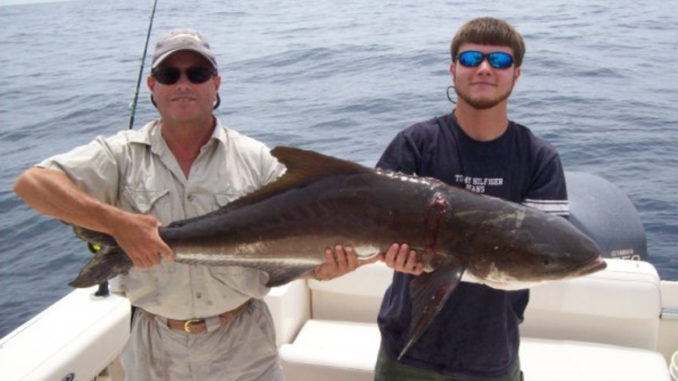
Nearshore reefs offer cobia, wide-open spaces
Every spring, especially in May, boats and anglers literally line up in the Broad River in hopes of catching a cobia. Commonly weighing more than 50 pounds, cobia are one of the biggest — not to mention tastiest — gamefish to visit South Carolina’s inshore waters, and the annual cobia run draws more and more anglers each year. Is catching a cobia worth dealing with the crowds? Absolutely; but there are much-less crowded alternatives a few miles away where the boats are fewer and the cobia even more plentiful.
The nearshore waters along South Carolina’s coast teem with cobia during the annual migration, and every artificial reef, patch of livebottom and buoy is an option for anglers. Taylor Thomas of Beaufort, one of the top cobia fisherman in South Carolina, catches dozens every spring, many of them off the beach.
“It costs more in fuel, but it’s worth it, because the catch rate is higher,” Taylor said.
Steve Roll of Seas So Shallow Guide Service in Beaufort is no stranger to cobia, and he knows how to catch the big boys nearshore when everyone else is coming home from the river empty-handed.
“The draw of going off is you can go to the Betsy Ross Reef and catch a dozen, versus sitting around in the river wondering if you are going to catch one,” he said.
Fishing inshore waters like the Broad River requires anglers to fish heavily weighted live bait on the bottom, float baits on top behind the boat or search for cobia cruising on the top during the slack water around tide change. Anglers fishing nearshore use many of the same techniques, but they often have more success due to less current and more-defined structure to target.
Many nearshore cobia are found on the top throughout the tide and are easier to spot due to improved water clarity. So instead of a fish or two cruising on top, anglers are more likely to find big schools of cobia. A rod rigged with a jig gives nearshore anglers the ability to react quickly when a school pops up on the surface and cruises past.
One method that has proven very effective for nearshore anglers is vertical jigging over structure. Roll prefers an 8000 Stradic reel loaded with 80-pound braid, a 60- to 80-pound fluorocarbon leader, and a Shimano Tallus rod for jigging. Roll’s jigging technique and reason for it is simple.
“I like to use a 4- to 6-ounce Spro bucktail tipped with a Gulp! grub when the fish are tight-lipped; I let it hit the bottom and rip it up over and over, and it just ticks the fish off, causing a reaction bite,” he said.
Indiscriminate eaters, feeding cobia will inhale almost any bait presented, but the majority of nearshore anglers prefer to use live menhaden. Many a trip starts with a search for birds diving near sandbars and other shallow areas in the sounds, a sure sign of schooled-up menhaden. Two or three casts of a net over a good school is usually all it takes to fill the bait tanks enough for a full day of fishing.
Fishing live bait on the bottom around heavy structure requires stout gear.
“I don’t play around with big fish; I use a Shimano TLD 30, 2-speed outfit spooled with 40 pound, hi-vis mono, 60- to 100-pound fluorocarbon leader, a 6- to 8-ounce weight on a slide, and a 7/0 Eagle Claw circle sea hook,” Roll said.
When it comes to which nearshore area is best, there is no wrong answer. Cobia stay on the move and may be concentrated on the Betsy Ross one day and on the Fripp Island reef the next, although almost all reefs will hold some cobia throughout the season. Thomas will often start off on one of the major reefs, and if it is crowded or the action slow, he will leave in search of nearby patches of livebottom where cobia often congregate.
“I’ll start searching with my sonar, first looking for anything protruding five or 10 feet off the bottom and then slow down and see if there are any big fish showing” he said.
Cobia relate to structure, even small structure. Experienced anglers are very aware of this fact and leave nothing to chance.
“You want to hit every buoy on the way out and the way back just in case there is a cobia or two hanging around them to cast too,” Roll said.
Any trip off of the coast, even if just a few miles, requires more preparation, boat, fuel and caution than an inshore trip does, but anglers who put in the extra effort to leave often find quite a few more fish and far fewer fisherman with whom to share them.




Be the first to comment